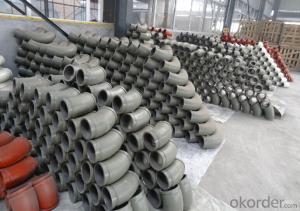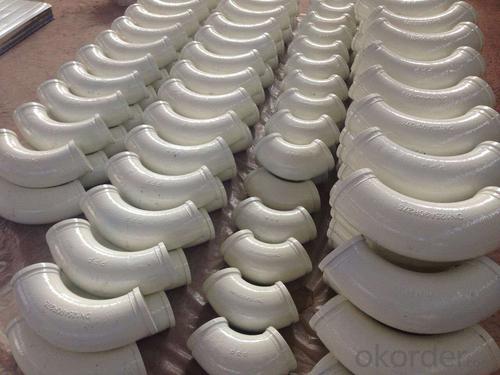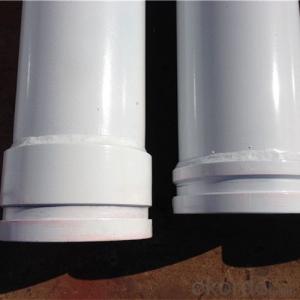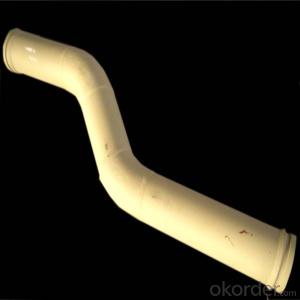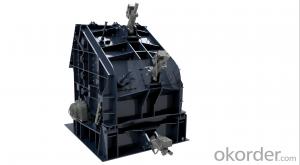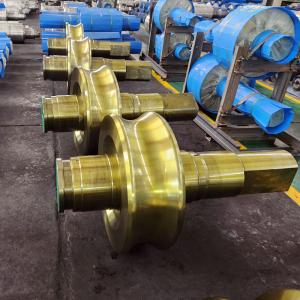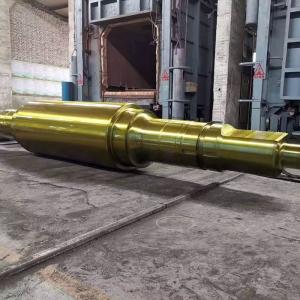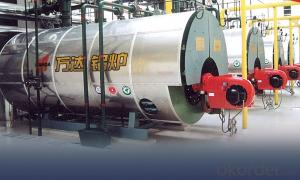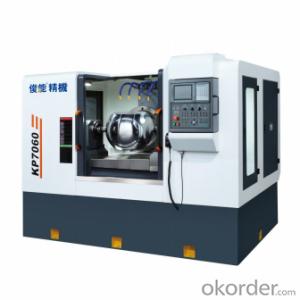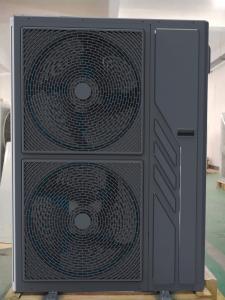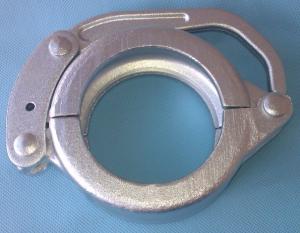CONCRETE DELIVERY ELBOW SCHWING TYPE 45DEG R275 DN125
- Loading Port:
- Tianjin
- Payment Terms:
- TT OR LC
- Min Order Qty:
- 100 pc
- Supply Capability:
- 10000 pc/month
OKorder Service Pledge
OKorder Financial Service
You Might Also Like
concrete pump elbow table
Wear-resistant Single or Double Concrete Pump Elbow | |||||||
Type | Singe Elbow | Double Elbow | |||||
Model | DN125 | DN150 | DN175 | DN125 | |||
Material | Casting Steel ,ST52 | Inside | 40Cr | Outside | |||
Size | R275*90° | R275*90°+110 | 36° | F2000 | R275*90° | R275*90°+110 | |
R275*45° | R275*90°+211 | R400*30° | A3000 | R275*45° | R275*90°+211 | ||
R275*25° | R275*90°+411 | R400*45° | 471B | R275*25° | R275*90°+411 | ||
R275*20° | R275*90°+424 | R400*30° | 571B | R275*20° | R275*90°+424 | ||
R275*15° | R275*45°+170 | R488*90° | A1000 | R275*15° | R275*45°+170 | ||
R180*90° | R275*45°+310 | R500*90 | C1000 | R180*90° | R275*45°+310 | ||
R232*60° | R275*45°+310 | R280*90° | B2000 | R232*60° | R275*45°+310 | ||
R240*36° | 20°Lengthen | R240*36° | 20°Lengthen | ||||
R240*30° | 25°+740 | R240*30° | 25°+740 | ||||
R240*15° | 40°Zoomlion | R240*15° | 40°Zoomlion | ||||
R385*29° | R385*29° | ||||||
R315*33° | R315*33° | ||||||
Technic | Forged | ||||||
Average life | 25,000cubic | 50,000cubic | |||||
Appliciation | Used in concrete transport in construction work | ||||||
1.product profile:The double layer concrete pump elbow is developed by ourselves through new
technology and process.
2.characteristic:the inner layer of this concrete pump elbow undergoes heat treatment,and then the rigitiry can reach 62-65HRC.
3.characteristic:the outer layer of the concrete pump elbow possess good toughness properties
to protect the inner layer,so the security of the elbow is improved.
4.life:the experiment done abroad shows that the life of our concrete pump elbow can reach 35000-50000cbm,got the customers' praise
5.Beside the double layer concrete pump elbow,we produce all kinds of concrete pump parts,
straight pipe hose flange coupling and so on.
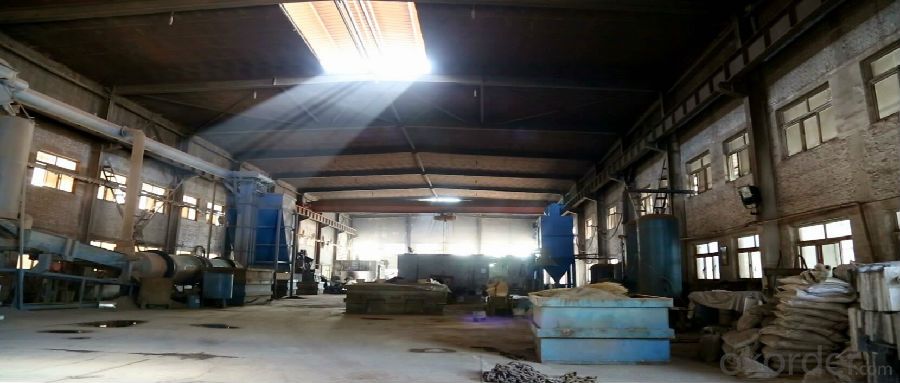
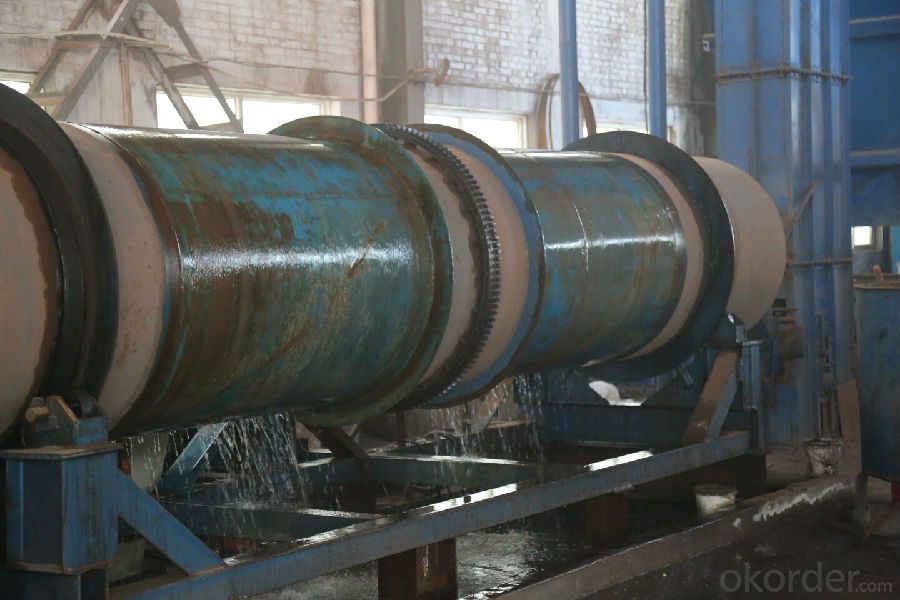

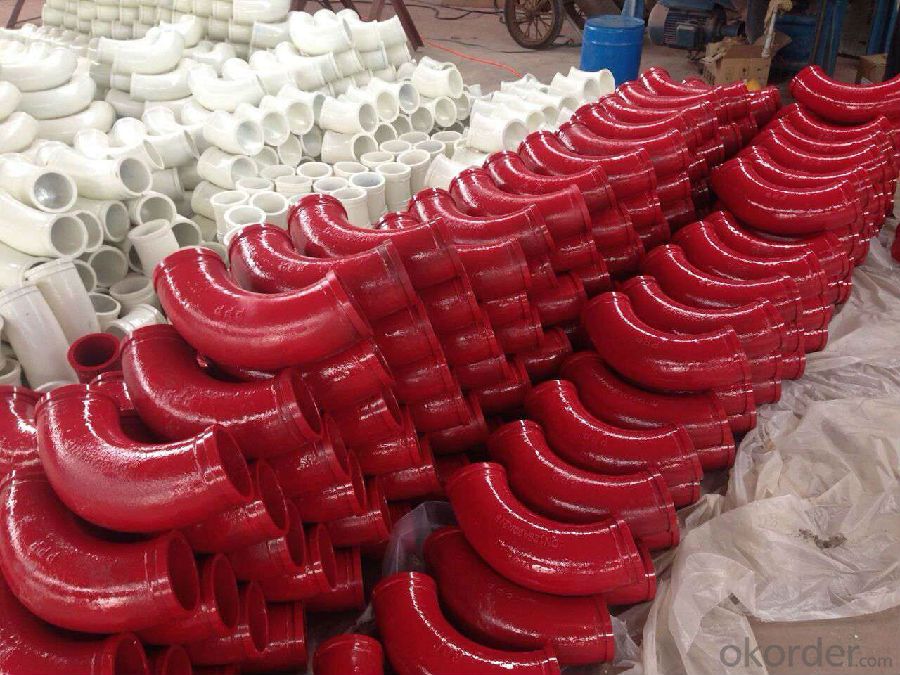
- Q:What are the elements of concrete pump and concrete pump truck selection?
- Concrete casting factors, concrete pump truck selection should be based on concrete engineering objects, characteristics, the requirements of the maximum transmission distance, concrete construction plan, concrete pump form and concrete conditions for comprehensive consideration
- Q:How can a malfunctioning control panel affect the pump's operation?
- The operation of a pump can be negatively affected by a control panel that is not functioning properly. Firstly, the control panel is responsible for monitoring and controlling various functions of the pump, including starting, stopping, and regulating the flow of fluids. If the control panel malfunctions, it may not send accurate signals to the pump, resulting in erratic or incorrect operation. Furthermore, a malfunctioning control panel can cause a breakdown in communication between the pump and other components or systems. For example, if the control panel fails to transmit important information to the pump's sensors or other control devices, the pump may not be able to respond appropriately to changes in pressure, temperature, or flow rate. This can lead to inefficient performance, potential damage to the pump, or even complete failure. Moreover, the safety of the pump's operation can be compromised by a malfunctioning control panel. Control panels often include safety features such as emergency shutdowns or alarms to prevent hazardous situations. If these safety mechanisms are compromised due to a malfunction, it can increase the risk of accidents, equipment damage, or harm to personnel. In conclusion, a malfunctioning control panel can disrupt the proper functioning of a pump by causing operational inconsistencies, loss of communication with other components, decreased efficiency, increased risk of accidents, and potential damage to the pump itself. Therefore, it is essential to regularly inspect and maintain control panels to ensure they function properly and minimize the chances of any negative impact on the pump's operation.
- Q:What are the potential risks associated with the installation and replacement of concrete pump spare parts?
- There are several potential risks associated with the installation and replacement of concrete pump spare parts. One of the main risks is the possibility of improper installation. If the spare parts are not installed correctly, it can lead to issues such as leaks, decreased performance, and even equipment failure. This can not only result in costly repairs but also pose a safety hazard to workers and those in the surrounding area. Another potential risk is the use of counterfeit or low-quality spare parts. These parts may not meet the necessary standards and specifications, which can compromise the integrity and functionality of the concrete pump. This can also increase the risk of equipment failure and accidents. Additionally, the installation and replacement process may require workers to operate heavy machinery, such as cranes or forklifts, which can be hazardous if not done properly. There is a risk of accidents, injuries, or damage to the equipment or surrounding structures if adequate precautions are not taken. Furthermore, concrete pump spare parts may contain hazardous materials or substances. Workers need to be aware of the potential risks associated with handling and disposing of these materials, such as exposure to harmful chemicals or environmental contamination. Lastly, there is a risk of delays and downtime during the installation and replacement process. If spare parts are not readily available or if there are issues with their compatibility, it can result in extended periods of equipment inoperability. This can lead to project delays, increased costs, and potential financial losses. To mitigate these risks, it is important to ensure proper training and supervision of workers involved in the installation and replacement of concrete pump spare parts. Using genuine and high-quality spare parts from reputable suppliers can also reduce the risk of equipment failure. Regular inspections, maintenance, and adherence to safety protocols are crucial to minimize the potential risks associated with this process.
- Q:How often should concrete pump remote controls be inspected and maintained?
- Concrete pump remote controls should be inspected and maintained on a regular basis to ensure their proper functioning and to prevent any potential issues. The frequency of inspections and maintenance will depend on various factors such as the intensity of use, environmental conditions, and the specific recommendations provided by the manufacturer. As a general guideline, it is recommended to inspect and maintain concrete pump remote controls at least once every three months. This includes checking for any visible damage, loose or worn-out parts, and ensuring that all buttons and switches are working properly. Additionally, it is important to inspect and clean the battery compartment, and replace batteries if necessary. However, in high-demand situations or extreme environmental conditions, more frequent inspections and maintenance may be required. For instance, if the concrete pump is used in a harsh environment with excessive dust or moisture, it may be necessary to increase the frequency of inspections and cleanings to prevent any potential damage or malfunction. It is also crucial to follow the manufacturer's guidelines and recommendations for maintenance. They may provide specific instructions on lubrication, calibration, or other maintenance procedures that should be performed at regular intervals. By adhering to these guidelines, concrete pump remote controls can be kept in optimal condition, ensuring safe and efficient operation.
- Q:How long do concrete pump spare parts typically last?
- The lifespan of concrete pump spare parts can vary depending on several factors such as usage frequency, maintenance practices, and the quality of the parts. However, on average, concrete pump spare parts are designed to last for several years before requiring replacement.
- Q:Can concrete pump valves be repaired or should they be replaced?
- Concrete pump valves can be repaired in most cases. However, if the damage is extensive or the valve is severely worn out, it might be more cost-effective to replace it instead of repairing it. The decision to repair or replace the valve depends on the specific situation and the advice of a professional.
- Q:How often should concrete pump pistons be inspected and replaced?
- Concrete pump pistons should be inspected and replaced regularly to ensure their optimal performance and prevent any potential malfunctions. The frequency of inspections and replacements will depend on various factors such as the type of concrete being pumped, the volume of concrete being pumped, and the operating conditions of the pump. As a general guideline, concrete pump pistons should be inspected and replaced every 500 to 1,000 hours of operation. However, this can vary depending on the specific pump manufacturer's recommendations, the quality of the concrete being pumped, and the maintenance and cleaning practices followed. Regular inspections should be conducted to check for any signs of wear, damage, or deterioration in the pistons. This includes examining the rubber seals, valve plates, and any other components that may affect the piston's performance. Any signs of cracks, tears, or excessive wear should prompt immediate replacement to prevent potential issues such as concrete leakage or loss of pressure. In addition to regular inspections, it is crucial to follow a preventive maintenance schedule that includes routine cleaning and lubrication of the pistons. This will help prolong their lifespan and ensure smooth operation. It is important to note that the specific recommendations for inspection and replacement intervals may vary between different pump manufacturers. Therefore, it is advisable to refer to the pump's operation and maintenance manual or consult with the manufacturer or a qualified technician to determine the ideal frequency for inspecting and replacing concrete pump pistons.
- Q:How can a faulty boom affect the concrete placement process?
- A faulty boom can significantly affect the concrete placement process. It can lead to uneven distribution of concrete, resulting in inconsistent concrete strength and quality. It may also cause the concrete to be placed in unintended areas or at incorrect heights, affecting the overall structural integrity of the project. Additionally, a faulty boom can pose a safety risk to workers and equipment involved in the concrete placement process.
- Q:How can a faulty oil cooler affect the pump's hydraulic system?
- The pump's hydraulic system can be affected in multiple ways by a defective oil cooler. Firstly, it is the responsibility of the oil cooler to maintain the hydraulic oil at an optimal temperature. If the oil cooler is flawed and fails to cool the oil efficiently, the hydraulic oil may become overheated. This can result in a decrease in the oil's viscosity, causing it to lose its lubricating properties. Consequently, the pump's moving parts may experience heightened friction and wear, leading to reduced efficiency and potential damage to the pump itself. Secondly, a defective oil cooler can lead to inadequate cooling of the hydraulic oil, resulting in elevated temperatures within the system. Elevated temperatures can cause the oil to oxidize, leading to the formation of sludge and varnish deposits. These deposits can obstruct the smooth operation of the hydraulic system, including the pump, valves, and other components, potentially causing malfunctions. Furthermore, a faulty oil cooler can also cause a decrease in the rate of oil flow. If the oil cooler is not functioning properly, it can restrict the flow of hydraulic oil, reducing the amount of oil available for the pump's operation. This can result in decreased hydraulic pressure, affecting the pump's performance and potentially causing issues such as reduced power output or inadequate operation of hydraulic actuators. In summary, a defective oil cooler can have negative effects on the pump's hydraulic system, including overheating, increased friction and wear, the formation of deposits, and a reduced oil flow rate. It is essential to regularly inspect and maintain the oil cooler to ensure proper functioning and prevent potential damage to the hydraulic system.
- Q:How do I properly maintain and replace wear plates in concrete pump spare parts?
- Properly maintaining and replacing wear plates in concrete pump spare parts is crucial for the optimal performance and longevity of your equipment. Here are the steps you can follow to ensure that the wear plates are properly maintained and replaced: 1. Regular inspection: It is important to regularly inspect the wear plates in your concrete pump spare parts to identify any signs of wear or damage. Look for cracks, excessive wear, or any other visible signs of deterioration. 2. Cleaning: Before replacing the wear plates, make sure to clean the area around them thoroughly. Remove any debris, dirt, or hardened concrete that might be present. Use a pressure washer or a wire brush to clean the surface properly. 3. Measure wear plate thickness: Measure the thickness of the wear plates using a precision measuring tool. Compare the current thickness with the manufacturer's recommended specifications to determine if replacement is necessary. If the wear plates are below the recommended thickness, it is time to replace them. 4. Remove old wear plates: Carefully remove the old wear plates using appropriate tools. Take note of their positions and any alignment marks to ensure correct installation of the new plates. 5. Prepare new wear plates: Before installing the new wear plates, ensure that they are of the correct size and specifications for your concrete pump. Check for any defects or damage in the new plates before proceeding. 6. Apply lubrication: Apply a thin layer of lubricant or anti-seize compound on the mating surface of the new wear plates. This will help prevent corrosion and ease future replacement. 7. Install the new wear plates: Position the new wear plates in the correct location, aligning them with any reference marks or indicators. Secure them tightly using the appropriate bolts or fasteners, making sure not to overtighten. 8. Test and check alignment: Once the new wear plates are installed, perform a test run of the concrete pump to ensure that everything is functioning properly. Check for any leaks, unusual vibrations, or misalignments. If any issues are detected, address them promptly. 9. Maintain regular maintenance schedule: To prevent premature wear and damage to the wear plates, establish a regular maintenance schedule. This may include cleaning, lubricating, and inspecting the wear plates at specified intervals or after a certain number of hours of operation. By following these steps and maintaining a proactive approach to wear plate maintenance and replacement, you can ensure the smooth operation and prolonged lifespan of your concrete pump spare parts.
1. Manufacturer Overview |
|
|---|---|
| Location | |
| Year Established | |
| Annual Output Value | |
| Main Markets | |
| Company Certifications | |
2. Manufacturer Certificates |
|
|---|---|
| a) Certification Name | |
| Range | |
| Reference | |
| Validity Period | |
3. Manufacturer Capability |
|
|---|---|
| a)Trade Capacity | |
| Nearest Port | |
| Export Percentage | |
| No.of Employees in Trade Department | |
| Language Spoken: | |
| b)Factory Information | |
| Factory Size: | |
| No. of Production Lines | |
| Contract Manufacturing | |
| Product Price Range | |
Send your message to us
CONCRETE DELIVERY ELBOW SCHWING TYPE 45DEG R275 DN125
- Loading Port:
- Tianjin
- Payment Terms:
- TT OR LC
- Min Order Qty:
- 100 pc
- Supply Capability:
- 10000 pc/month
OKorder Service Pledge
OKorder Financial Service
Similar products
New products
Hot products
Hot Searches
Related keywords

